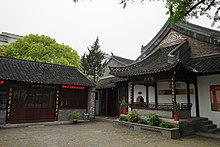| Crane Mosque | |
|---|---|
| 仙鹤寺 | |
 | |
| Religion | |
| Affiliation | Islam |
| Branch/tradition | Sunni |
| Location | |
| Location | Yangzhou, Jiangsu, China |
 | |
| Geographic coordinates | 32°23′48″N 119°26′24″E / 32.396556°N 119.439883°E / 32.396556; 119.439883 |
| Architecture | |
| Type | mosque |
| Style | Chinese |
| Founder | Puhading |
| Date established | 1275 |
| Completed | 1390 (reconstruction) |
| Crane Mosque | |||||||||
|---|---|---|---|---|---|---|---|---|---|
| Traditional Chinese | 仙鶴寺 | ||||||||
| Simplified Chinese | 仙鹤寺 | ||||||||
| Literal meaning | Immortal Crane Temple | ||||||||
| |||||||||
| Qingbai Liufang Mosque | |||||||||
| Chinese | 清白流芳大寺 | ||||||||
| Literal meaning | Pure & Renowned Great Temple | ||||||||
| |||||||||
Crane Mosque, also known by its Chinese name as the Xianhe Mosque and by other names, is a mosque located in Yangzhou, Jiangsu, China.
Names
The English name Crane Mosque is a partial calque of its Chinese name 仙鶴寺, pronounced Xiānhè Sì in Mandarin. The name is sometimes explained by the supposed resemblance of the mosque's shape to a crane, although the Chinese name references a Taoist immortal. As the most historically important mosque in the city, it is also known as the Yangzhou Mosque and as the Qingbai Liufang Mosque.
History
Crane Mosque was supposedly built in 1275 by the Arab Muslim Puhaddin, a 16th-generation descendant of Muhammad, the year after his death and the year before the Mongol general Bayan received the surrender of Yangzhou following Li Tingzhi's execution by the Southern Song.
The mosque was severely damaged during the Red Turban Rebellion that ended the Mongolian Yuan dynasty. An Arab Muslim named Hasan rebuilt the mosque in 1390 under the early Ming. It was further renovated and refurbished in 1523 under the Jiajing Emperor.
The Crane Mosque is accounted as one of the Four Great Mosques of China—alongside the Huaisheng, Qingjing, and Phoenix Mosques in Guangzhou, Quanzhou, and Hangzhou—and was inscribed as a cultural relic protected by the Jiangsu government in April 1995. It now includes a small collection of documents concerning China's relations with Muslim countries.
References
Citations
- ^ Sha Zongping (沙宗平); Wang Jianping (王建平) (7 July 2021). 中国伊斯兰教建筑珍品:仙鹤寺. chinaislam.net.cn (in Chinese). Retrieved 21 July 2021.
- ^ 仙鹤寺. Government of Yangzhou (in Chinese). 6 December 2011. Archived from the original on 21 July 2021. Retrieved 21 July 2021.
- ^ 仙鹤寺(组图). sina (in Chinese). 17 April 2006. Retrieved 21 July 2021.
- ^ Lin Yuanqin (林元沁) (7 April 2015). 扬州:仙鹤寺 伊斯兰教清真寺. ifeng.com (in Chinese). Retrieved 21 July 2021.
- Olivová (2009), p. 30.
- Waterson (2013), p. 230.
- Olivová (2009), p. 6.
- "Garden Tomb of Puhaddin", El Segundo: Fodor's Travel
{{citation}}: Missing or empty|title=(help).
Bibliography
- Olivová, Lucie B. (2009), "Building History and the Preservation of Yangzhou", Lifestyle and Entertainment in Yangzhou, NIAS Studies in Asian Topics, No. 44, Copenhagen: Nordic Institute of Asian Studies, pp. 3–36, ISBN 9788776940355.
- Waterson, James (2013), Defending Heaven: China's Mongol Wars, 1209–1370, Havertown: Casemate Publishers, ISBN 978-1783469437.
External links
- Jumma prayer at the Crane Mosque, YouTube, 17 March 2023.
This article about a mosque or other Islamic place of worship in China is a stub. You can help Misplaced Pages by expanding it. |